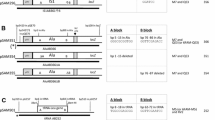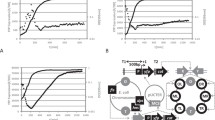Abstract
Previous studies from this laboratory have characterized a 174 by enhancer element which is located 2kb upstream of the initiation site. Half of the enhancer action is controlled by a 37 by element at the 3′ end of the 174 by region. We now report that a 43 by adjacent domain which is located upstream of the 37 by element constitutes an additional motif of the rDNA enhancer. When the plasmid consisting of the 43 by DNA upstream of the rDNA core promoter was transcribed in a fractionated rat tumor cell extract (fraction DE-B), transcription of rDNA was augmented 4 fold. Electrophoretic mobility shift and DNAase I footprinting analyses showed that the purified 37 by enhancer (E1)-binding protein, (E1BF) not only interacted with the enhancer motif El but also interacted with the neighbouring 43 by enhancer domain E2. The specificity of the binding was demonstrated by competition with unlabeled 37 by and 43 by fragment and lack of competition with nonspecific DNAs in the mobility shift assay. These studies have shown that a single pol I transcription factor can bind to multiple enhancer domains with no significant sequence homologies and such multiple interactions may result in maximal transcription of ribosomal gene from the core promoter.
Similar content being viewed by others
References
Moreau P, Hen R, Wasylyk B, Everett R, Gaub MP, Chambon P: The SV40 72 base pair repeat has a striking effect on gene expression both in SV40 and other chimeric recombinants. Nucleic Acids Res 9: 6047–6068, 1981
Banerji R, Rusconi S, Schaffner W: Expression of a β-globin gene is enhanced by remote SV40DNA sequence. Cell 27: 299–308, 1981
Chambon P, Dierich A, Gaub MP, Jakowlev SB, Jongstra J, Krust A, LePennec JP, Oudet P, Reudelhuber T: Promoter elements of genes coding for proteins and modulation of transcription by estrogens and progesterone. Recent Prog Horm Res 40: 1–42, 1984
Gruss P: Magic enhancers. DNA 3: 1–5, 1984
Yaniv M: Two distinct enhancers with different cell specificities coexist in the regulatory region of polyoma. Cell 39: 653–662, 1984
Serfling E, Jasin M, Schaffner W: Enhancers and eukaryotic gene transcription. Trands Genet 1: 224–230, 1985
Reeder RH, Roan JG, Dunaway M: Spacer regulation of Xenopus ribosomal gene transcription. Competition in oocytes. Cell 35: 449–456, 1983
Dixit A, Garg LC, Chao W, Jacob ST: An enhancer element in the far upstream spacer region of rat ribosomal RNA gene. J Biol Chem 262: 11616–11622, 1987
DeWinter RFJ, Moss T: A complex array of sequences enhances ribosomal transcription in Xenopus laevis. J Mol Biol 196: 813–827, 1987
Garg LC, Dixit A, Jacob ST: A 37-base pair element in the far upstream spacer region can enhance transcription of rat rDNA in vitro and can bind to the core promoter-binding factor(s). J Biol Chem 264: 220–224, 1989
Zhang J, Jacob ST: Purification and characterization of a novel factor which stimulates rat ribosomal gene transcription in vitro by interaction with an enhancer element and core promoter. Mol Cell Biol 10: 5177–5186, 1990
Rothblum LI, Reddy R, Cassidy B: Transcription initiation site of rat ribosomal DNA. Nucleic Acids Res 10: 7345–7362, 1982
Harrington CA, Chikaraishi DM: Identification and sequence of the initiation site for rat 45S ribosomal RNA synthesis. Nucleic Acids Res 11: 3317–3332, 1983
Kurl RN, Rothblum LI, Jacob ST: A purified fraction containing RNA polymerase I that can accurately transcribe rat ribosomal RNA gene. Proc Natl Acad Sci USA 81: 6672–6675, 1984
Schatt MD, Rusconi S, Schaffner W: A single DNA-binding transcription factor is sufficient for activation from a distant enhancer and/or from a promoter position. EMBO J 9: 481–487, 1990
Pinkert CA, Ornits DM, Brinster RL, Palmiter RD: An albumin enhancer located 10 kb upstream functions along with its promoter to direct, liver-specific expression in transgenic mice. Genes and Dev 1: 268–276, 1987
Pikaard CS, McStay B, Schultz MC, Bell SP, Reeder RH: The Xenopus ribosomal gene enhancers bind an essential polymerase I transcription factor, xUBF. Genes Dev 3: 1779–1788, 1989
Pfeifer K, Prezant T, Guarante L: Yeast HAP1 activator binds to two upstream activation sites of different sequence. Cell 49: 19–27, 1987
Fisher RP, Clayton D: Purification and characterization of human mitochondrial transcription factor 1. Mol Cell Biol 8: 3496–3509, 1988
Bell SP, Pikaard CS, Reeder RH, Tjian R: Molecular mechanisms governing species-specific transcription of ribosomal RNA. Cell 59: 489–497, 1989
Ptashne M: How eukaryotic transcriptional activators work. Nature 335: 683–689, 1988
Davidson I, Xiao JH, Rosales R, Staub A, Chambon P: The HeLa cell protein TEF-1 binds specifically and cooperatively to two SV40 enhancer motifs of unrelated seqence. Cell 54: 931–942, 1988
Hammer RE, Krumlauf R, Camper SA, Brinster RL, Tilghman SM: Diversity of alpha-fetoprotein gene expression in mice is generated by a combination of separate enhancer elements. Science 235: 53–58, 1987
Shirm S, Jiricny J, Schaffner W: The SV40 enhancer can be dissected into multiple segments, each with a different cell type specificity. Genes and Dev 1: 65–74, 1987
Lenardo M, Pierce JW, Baltimore D: Protein-binding motifs in immunoglobin enhancers determine transcriptional activity and inducibility. Science 236: 1573–1577, 1987
Author information
Authors and Affiliations
Rights and permissions
About this article
Cite this article
Jacob, S.T., Zhang, J., Garg, L.C. et al. Multiple functional enhancer motifs of rat ribosomal gene. Mol Cell Biochem 104, 155–162 (1991). https://doi.org/10.1007/BF00229815
Issue Date:
DOI: https://doi.org/10.1007/BF00229815




